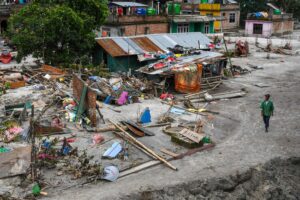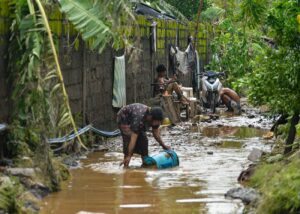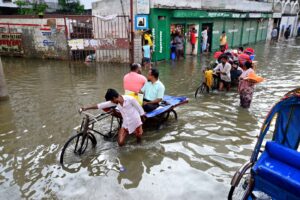The “wealthiest 10%” of people on the planet are “responsible” for 65% of the 0.61C increase in global average temperatures over 1990-2020, according to new research.
The study, published in Nature Climate Change, uses a field of climate science called “attribution” to determine the contribution of the world’s “wealthiest population groups” to climate change through the greenhouse gases they emit.
The authors also calculate the contribution of these high-income groups to the increasing frequency of heatwaves and droughts.
For example, the study finds the wealthiest 10% of people – defined as those who earn at least €42,980 (£36,605) per year – contributed seven times more to the rise in monthly heat extremes around the world than the global average.
In another finding, the Amazon rainforest faced a threefold increase in the likelihood of droughts over the period studied, most of which was driven by the wealthiest 10% of the world’s population.
The authors also explore country-level emissions, finding that from the wealthiest 10% in the US produced the emissions that caused a doubling in heat extremes across “vulnerable regions” globally.
One scientist not involved in the study tells Carbon Brief that efforts to attribute global warming to individual income groups is an “important step towards targeted policies” and could support climate litigation.
Emissions inequality
Humans emit more than 40bn tonnes of CO2 into the atmosphere every year. Developed countries are responsible for the majority of global emissions, as a result of the typically more carbon-intensive lifestyles of their residents.
Meanwhile, the most severe impacts of climate change are disproportionately felt by the poorest and most vulnerable people.
The new study uses an income and wealth inequality dataset from the World Inequality Database to track inequality over 1990-2019, showing how much the world’s wealthiest 10%, 1% and 0.1% of society have contributed to warming over 1990-2020. (For details on the method, see the modelling inequalities section below.)
The world’s wealthiest 10% all earn more than €42,980 (£36,605) per year, according to the database. Meanwhile, the world’s wealthiest 0.1% earn more than €537,770 (£458,011) per year.
Of the 0.61C increase in global average temperatures over 1990-2020, the authors estimate that 65% was due to the emissions of the wealthiest 10% of people on the planet. For the wealthiest 0.1%, the estimate is 8%.
The graph below shows how much global temperatures would have risen over 1990-2020 if everyone in the world emitted as much as the world’s poorest 50% (purple), middle 40% (green), richest 10% (orange), richest 1% (blue) and richest 0.1% (pink) people. The grey bar shows how much global temperatures actually rose.
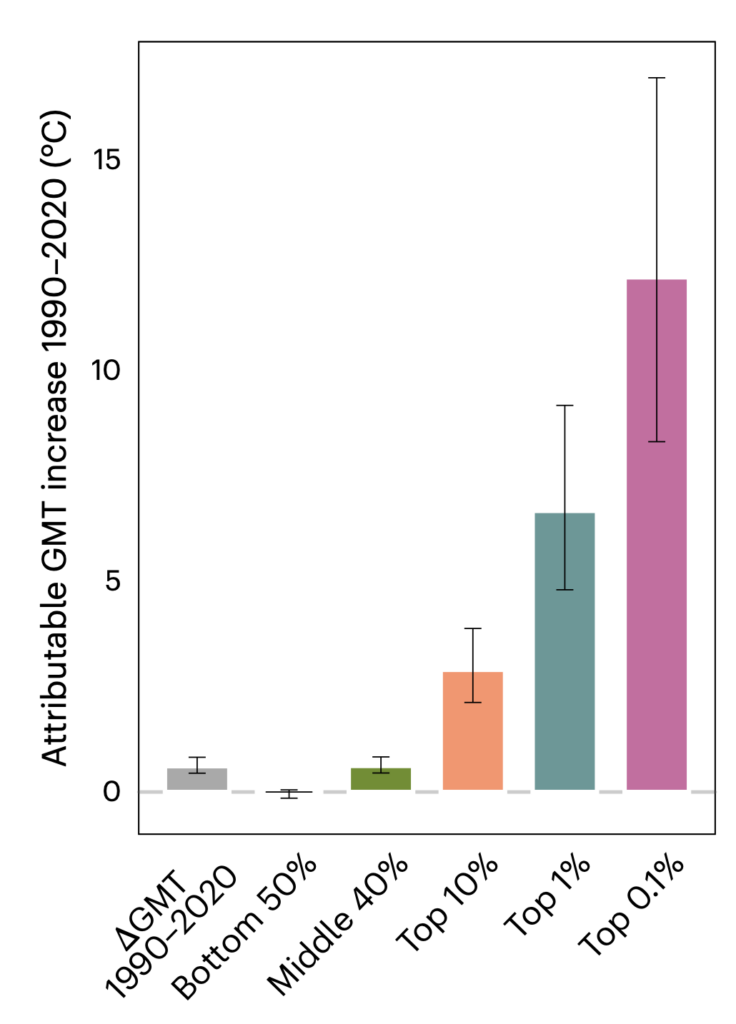
How global temperatures would have risen if everyone in the world emitted the world produced the same amount of emissions, on average, as individuals in the bottom 50% (purple), middle 40% (green), top 10% (orange), top 1% (blue) and top 0.1% (pink) of the world’s emitters. Source: Schöngart et al (2025).
The authors find that if the whole world had emitted as much as the wealthiest 10% of people over 1990-2020, global average temperatures would have risen by 2.9C, instead of 0.61C. If the global population had emissions as large as the wealthiest 0.1%, temperatures would have risen by 12.2C.
Meanwhile, the study calculates that if the whole world had emissions as low as the poorest 50%, global temperatures would have remained close to 1990 levels.
Hot and dry extremes
As greenhouse gas emissions cause the climate to warm, extreme weather events such as heatwaves and droughts are becoming more intense, frequent and long-lasting.
The authors use attribution – a field of climate science that aims to identify the “fingerprint” of global warming on these events – to determine the contribution of the emissions of the world’s wealthiest people to the increasing frequency of heatwaves and droughts.
The authors assess “extremely hot” and “extremely dry” months, defined as the most extreme 1% of months in a pre-industrial climate during the hottest month of the year regionally. (In a pre-industrial climate, only one of each extreme would be expected every 100 years on average.)
The graphs below show the number of additional heatwaves (left) and droughts (right) that have occurred since 1990 due to climate change in different regions of the world.
The full bar shows the total number of additional heatwaves due to human-cased climate change in each region. The green bar shows additional occurrences due to the wealthiest 1%. The green and orange bars combined show the wealthiest 10%.
The numbers in green and orange show how much the wealthiest 1% and 10% of the planet contributed to the extreme, compared to the global average. (For example, an orange number of 7.0 means that the wealthiest 10% of people contributed seven times more to the extreme event than the global average.)

The study finds that an average of 11.5 additional heat events observed in August – the month where the rise in heat extremes is, on average, most pronounced – are attributable to the wealthiest 10%.
It also calculates that emissions from this group resulted in, on average, an additional 2.3 droughts in the Amazon in October – the month with the strongest attributable drying trend in the region.
Highest emitters
The authors also assess the contributions of the wealthiest people to climate extremes on a country level, identifying the US, the EU, China and India as the world’s four highest emitting regions.
The graphic below shows the increase in frequency of one-in-100 year peak summer heat extremes in selected regions attributable to the wealthiest 10% of people (left) and 1% of people (right) in China (red), the US (pink), the EU (peach) and India (blue).
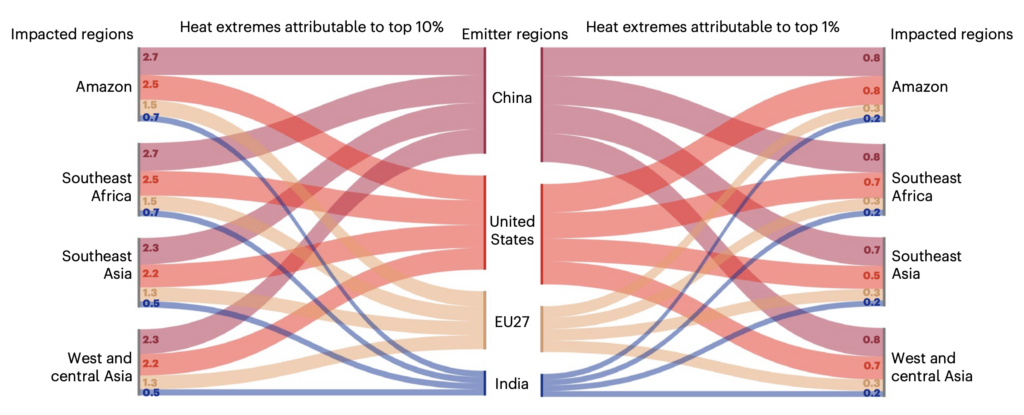
Emissions from the wealthiest 10% in the US resulted in an average of 1.3 extra heat events globally, the authors find. However, this increase is distributed unevenly across the globe.
For example, the authors find this income group was responsible for the emissions that contributed to 2.7 additional heat events in “heat-affected areas” such as the Amazon and south-east Africa.
Emissions from the wealthiest 10% of people in the EU resulted in an additional 1.5 heatwaves in both the Amazon and south-east Africa.
Meanwhile, the Amazon faces 2.1 more heat extremes in 2020 than in 1990 due to the emissions of the richest 1% in the US, China, EU and India.
While inequalities between one country or region and another are well documented, it should also be noted that “inequalities within developing countries are increasing”, Dr Carl Schleussner, study author and leader of the integrated climate impacts research group at the International Institute for Applied Systems Analysis (IIASA), tells Carbon Brief.
For example, he notes that the paper shows “very high levels” of emissions from “the Chinese middle and upper classes”.
However, he says that many existing global frameworks to address climate change “treat countries as a whole” and fail to “differentiate” between income groups within countries.
Schleussner argues that the study highlights the need for “progressive policies” for climate action, which involve “tackling particularly high emitters” in all countries.
Dr Sarah Schöngart, a researcher at ETH Zurich and lead author of the study, tells Carbon Brief that studies such as this could provide important evidence in loss and damage litigation.
Prof Jakob Zscheischler, an Earth system scientist at the Helmholtz Centre for Environmental Research who was not involved in the study, also highlights the ways the findings could be used in climate-change lawsuits. He tells Carbon Brief:
“Quantifying the contribution of individual income groups to global warming and changes in climate extremes is an important step towards targeted policies and further supports climate litigation. Supporting climate injustice with concrete numbers will hopefully help the most vulnerable and least responsible strengthen their case.”
Modelling inequalities
The study uses a range of methods to attribute changes in heat and drought to the emissions of particular wealth groups. To model global greenhouse gas emissions by wealth group, the paper uses a “wealth-based carbon inequality assessment” from a 2022 study.
(See Carbon Brief’s coverage of the 2022 study.)
The study uses income and wealth inequality dataset from the World Inequality Database to track inequality over 1990-2019. It combines economic data with information on per-capita carbon footprints – calculated using “input-output” methodologies combined with data from the “distributional national accounts” project.”
The model considers three factors. The first is private consumption – made up of emissions from the direct use of fossil fuels and emissions embedded into goods and services. The second includes emissions from government spending in that person’s country – such as government administration, public roads or defence. The final component of a person’s carbon footprint is from their investments.
The authors then created a series of “counterfactual” emissions pathways, which imagine the world without the emissions of the wealthiest 10%, 1% and 0.1% of society, respectively. The emissions pathways include CO2, methane and nitrous oxide emissions, expressed as CO2-equivalent.
Lead author Schöngart tells Carbon Brief that including methane in the models is important, because it has “really high potency and near-term warming”. However, she notes that the team needed to make some assumptions about methane emissions – for example, assuming that each income group emits the same relative amount of methane compared to other greenhouse gas emissions.
Using a “simple” climate model called MAGICC, the authors model global average temperatures under these counterfactual emissions pathways. This allows them to calculate how much the planet would have warmed over 1990-2020 without the emissions of the 10%, 1% and 0.1% of society, respectively.
The authors use the global average temperature trends to produce temperature and rainfall data for every land-based grid square on Earth via a climate model emulator called MESMER.
Schöngart tells Carbon Brief that an emulator is “an approximation of an Earth system model” which “allows us to generate incredible amounts of data”, while using less computing power and taking less time to run.
The study authors then use attribution methods to identify how the emissions from the world’s wealthiest members of society have affected the frequency of heatwaves and droughts, by comparing the world as it is to a “counterfactual” world without human-caused climate change.
The graphic below shows these steps.

Earth system scientist Zscheischler praises the methods in the study. He tells Carbon Brief that “the main innovation of work lies in its novel combination of relatively simple emulators that capture the most important relationships between emissions and global warming and changes in extremes”.
He adds that emulators have been evaluated in other studies and are “trustworthy for this type of delicate analysis”.
Prof Wim Thiery – an associate professor at Vrije Universiteit Brussel, who was not involved in the study – also commends the use of emulators. He tells Carbon Brief that “producing the information presented in this study with a suite of full-blown Earth system models is impossible from a computational cost and human effort perspective”.
The post Two-thirds of global warming since 1990 caused by world’s ‘wealthiest 10%’ appeared first on Carbon Brief.
Two-thirds of global warming since 1990 caused by world’s ‘wealthiest 10%’
Climate Change
COP30 Bulletin Day 7: Brazil outlines options for a possible deal in Belém
Last Monday, to get the COP30 agenda agreed, Brazil promised to hold consultations on four controversial issues: emissions-cutting, transparency, trade and finance. Last night, after most delegates had spent their day off exploring the Amazon, the Presidency released a five-page document summarising what was said in those consultations.
Nothing in that “summary note” has been agreed by countries. But it collects together divergent views and forms the basis of what could become a politically agreed statement (known in the jargon as a cover decision) at the end of the COP. It has three key strands on boosting climate finance, strengthening emissions reductions and tackling trade measures linked to decarbonisation.
It includes the key rhetorical messages the COP30 presidency wants to include – that this is a “COP of Truth”, multilateralism is alive (despite President Trump’s efforts to thwart climate action) and the Paris Agreement is now moving from negotiation to implementation.
On emissions-cutting and the need to raise ambition – sorely lacking after the latest round of national climate plans (NDCs) – the note includes an option to hold an annual review and explore the “opportunities, barriers and enablers” to achieve the global efforts agreed at COP28 in Dubai to triple renewable energy and double energy efficiency by 2030; accelerate action to transition away from fossil fuels; and halt and reverse deforestation. This is essentially where any reference to a roadmap to transition away from fossil fuels could be anchored.
The document also includes proposals to “urge” developed nations to include finance in their NDC climate plans and “encourage” all countries that have set a range of percentage emissions reductions in their NDCs – like the EU’s 66.25-72.5% – to move toward the upper end of the range.
On finance, options include a three-year work programme on provision of finance by wealthy governments and a goal to triple adaptation finance (something the least-developed countries are pushing for) or just repeating the finance goal agreed at COP29 and “noting” a new roadmap to achieve that (which rich nations very much prefer).
There are also various options for how to talk about where climate and trade overlap: an annual dialogue, roundtables, consultations, a new platform or just to keep discussing in the ‘response measures’ strand of climate talks.
Li Shuo, head of the Asia Society Policy Institute’s China Climate Hub, told Climate Home News it was highly significant that – after two years of the issue being buried in climate talks – trade has now been “anchored in the endgame of this COP”.
The various potential outcomes in the summary note could be included in existing agenda items or they could be lumped together into what is usually referred to as a cover text but the Brazilian government would likely prefer to call a “mutirão decision” or a delivery, response or global action plan.
Essentially, after governments ignored the presidency’s pleas not to add contentious items to the agenda, it looks like they could get at least some of what they want by turning those issues into the headline deal from COP30 .

At the start of the high-level segment of the conference on Monday morning, where environment ministers deliver their speeches, UN climate chief Simon Stiell urged governments “to get to the hardest issues fast”.
“When these issues get pushed deep into extra time, everybody loses. We absolutely cannot afford to waste time on tactical delays or stone-walling,” he added.
The presidency consultations on the issues in the note will continue on Monday, along with negotiations on adaptation metrics and a Just Transition Work Programme among others. The COP30 president then plans to convene a “Mutirao” meeting of ministers and heads of delegation on Tuesday “to bring together various outcomes”.
Korea joins coal phase-out coalition at COP30
As fossil fuels have grabbed headlines at COP30, major coal producer South Korea kicked off the second week of the Belém conference with an actual concrete pledge: the country will phase out most of its coal power by 2040.
Operating the seventh-largest coal fleet in the world, Korea announced on Monday that it will join the Powering Past Coal Alliance (PPCA), an initiative launched in 2017 by the UK and Canada to encourage countries to wean themselves off the planet’s largest source of emissions. Oil and gas exporter Bahrain is another new member.
Asian industrial giant Korea said that out of 62 operating coal power plants, it will commit to retiring 40 of them by 2040. The phase-out date of the remaining 22 plants “will be determined based on economic and environmental feasibility”.
Korean Minister of Environment Kim Sung-Hwan said at an event announcing the pledge that the country will play a “leading role” in the energy transition.
“South Korea is known as a manufacturing powerhouse. Unfortunately renewable energy has taken a low share in our power mix, but going forward we are determined to foster renewable energy industries,” he told journalists. “We will show the world that we can create a decarbonised energy transition.”
Asked about a fossil fuel transition roadmap – an idea floated around by many governments in Belém – Sung-Hwan said “humanity and all of the governments should work together to achieve a decarbonised green transition”, adding that “COP30 will be an important momentum”.
UK climate minister Katie White said Korea was taking an “ambitious step”, and that they can “reap the rewards that we are seeing from our own clean energy transition”.
Korea is a major importer of oil and gas. Domestically, it has historically relied on coal for electricity, but the country’s production of the fossil fuel has decreased steadily by 86% in the last 25 years, according to the International Energy Agency (IEA). Their nuclear fleet, on the other hand, has nearly doubled in the same time period.
The post COP30 Bulletin Day 7: Brazil outlines options for a possible deal in Belém appeared first on Climate Home News.
COP30 Bulletin Day 7: Brazil sets out options to reach a deal in Belém
Climate Change
Your Summary of Negotiations: Nov. 17
Frustration about slow progress at the United Nations Climate Conference boiled over last week, when on Tuesday, Indigenous activists pushed past security at the entrance of the main conference hall, called the Blue Zone, and briefly occupied the space. The action was meant to draw attention to the exclusivity that happens at the COPs. Danielle Falzon, a sociologist at Rutgers University, who researches the climate talks, says, “In the UNFCCC setting, success is measured by how long you stay in the room, how polished your presentation is, how fluent you are in bureaucratic English — and how well you can pretend that the world isn’t burning outside.”
Sônia Guajajara, Brazilian minister of the Indigenous peoples, stated in an interview that nearly 5,000 Indigenous people were participating in various events around the city, with about 900 granted official accreditation to participate in events inside the Blue Zone. Analysis finds 1,600 fossil fuel representatives at UN climate summit in Brazil, outnumbering almost every country delegation aside from Brazil. “There is no solution to avoid climate change without the participation of Indigenous people; they need to be here,” said Guajajara.
On Friday morning, dozens of Indigenous activists blocked the front of the COP30 summit venue, staging a sit-in that forced delegates to use a side entrance to resume their negotiations on tackling climate change. Security has increased checks, and lines to enter are getting longer.
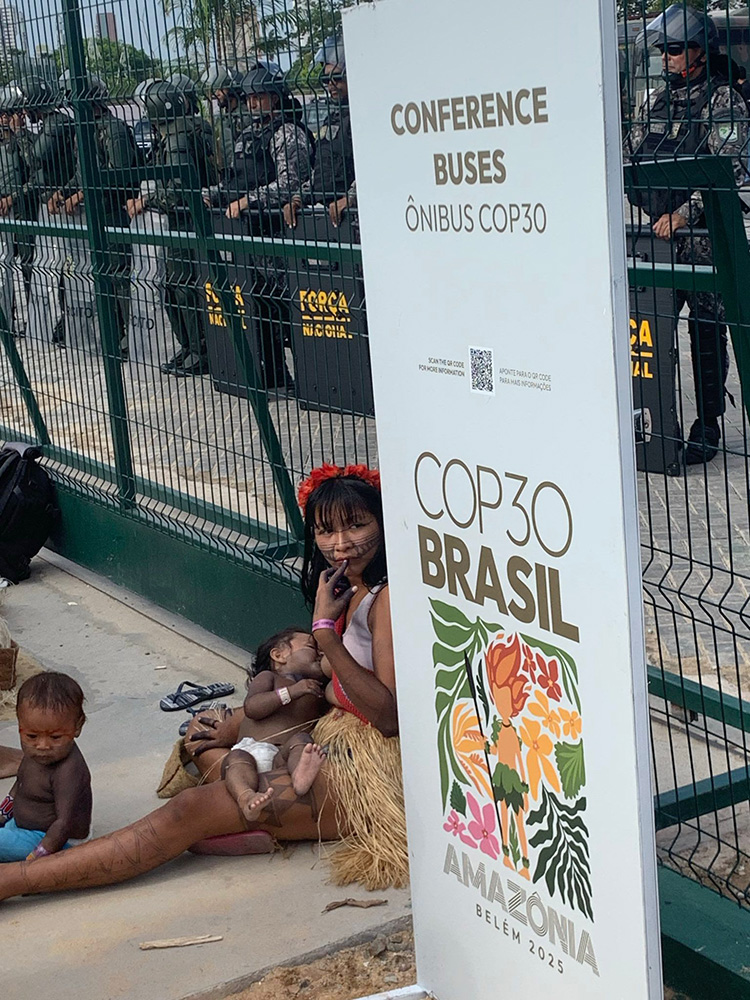
Meanwhile, a parallel event, called the People’s Summit, was inaugurated on Wednesday at the Federal University of Para, after a flotilla of more than 5,000 people aboard around 200 vessels sailed together in the waters around Belem to arrive at the venue. The People’s Summit has been convening alongside the official COP since 1992, making space for frontline communities to raise voices together. You can read their manifesto here.
International activists are calling for a treaty to phase out fossil fuels and address the root cause of the climate crisis. “If we continue to extract hydrocarbons from the Earth, we will exterminate ourselves,” said Olivia Bissa, president of the Chapra Nation in the Peruvian Amazon.
Transparency International’s examination of the list of registered participants found that 54% of participants in national delegations either did not disclose the type of affiliation they have or selected a vague category such as “Guest” or “Other.” The UNFCCC still lacks a conflict of interest policy for attendees. This enables fossil fuel businesses to use the space to unduly influence negotiations, strike side deals, and spread climate disinformation.
On Thursday, Brazil launched the Belém Health Action Plan, a blueprint to help health ministries respond to the effects of climate breakdown. It also identifies children as a uniquely vulnerable group for the first time.
There has been much speculation about the Trump administration’s leaving the Paris Agreement and the absence of the US in this COP’s negotiations. The US Climate Action Network held a press conference on Thursday to make it known that frontline communities and climate justice organizations from the US have not retreated. Christiana Figueres, a Costa Rican diplomat who played an essential role in the Paris Agreement, commented, “What the US has done is a choice; it is a sad choice, but it does not stop the advance of all others who are on the [clean energy] track,” Figueres says. “All it has done is open up the space hugely for China, which is completely delighted that they don’t have any substantial competition.”
Indeed, China is leading the world in renewable energy. In 2022, China installed roughly as much solar capacity as the rest of the world combined, then doubled its additional solar capacity in 2023. On Tuesday, the Climate Action Network gave a Ray of the Day Award to the G77 + China negotiating bloc for calling for the establishment of a Just Transition Mechanism under the UNFCCC — a proposal that mirrors many of the core elements civil society and trade unions have been advancing through the Belém Action Mechanism (BAM):
- Integrating fairness and equity into all levels of implementation;
- Promoting coordination and knowledge-sharing across sectors and institutions;
- Supporting non-debt-creating finance for transitions;
- Strengthening social dialogue; and
- Ensuring that people, not profits, remain at the heart of climate action.
On Saturday, thousands took to the streets outside the conference for the People’s Summit March. The joyous and defiant demonstration was the first major protest outside the annual climate talks since COP26 four years ago in Glasgow, as the last three gatherings were held in petrostates headed by authoritarian governments with questionable human rights records and little tolerance for demonstrations — Egypt, Dubai, and Azerbaijan.
Negotiations around finance, especially for adaptation and loss and damage, will likely heat up in this second week. The absence of meaningful finance at COP30 has been striking. Richer nations have repeatedly shirked their responsibilities and are dragging their feet on new commitments, despite being the primary contributors to global warming emissions. Some are even resorting to creative accounting. Canada’s repackaging of the final portion of its existing commitments as “new” funding is especially disappointing. Relying on uncertain private sector funds or loans leaves lower-income nations exposed to further economic risks and debts, rather than delivering the climate justice they deserve.
The post Your Summary of Negotiations: Nov. 17 appeared first on Climate Generation.
Climate Change
Week One at COP30: Reflections from the Amazon
Standing in the Blue Zone in Belém, Brazil, surrounded by thousands of negotiators, activists, scientists, and Indigenous leaders, I’m struck by how profoundly location shapes conversation. This is the first COP held in the Amazon rainforest—not symbolically nearby, but actually within it.
Through Climate Generation’s support, I’m able to spend two weeks here building strategic relationships and supporting mission-driven organizations. Their partnership — rooted in a mission to ignite and sustain the ability of educators, youth, and communities to act on systems perpetuating the climate crisis — enables Terra40 to deliver strategic event campaigns that include comprehensive Event Planning, Marketing, and Delegation Management to organizations like HBCU Green Fund at COP30.
Here’s what the first week has taught me.
The Beautiful Congregation
One of my favorite aspects of global forums is the congregation itself: diverse nations, peoples, and languages weaving together in one space. You hear Portuguese, Spanish, French, Chinese, Indigenous languages, Arabic — all at once. It’s a powerful reminder that we’re interconnected yet unique, each bringing something distinct to the table, yet all here for the same urgent purpose. But that diversity isn’t just poetic — it’s strategic. Different cultures approach negotiation, relationship building, and decision-making in fundamentally distinct ways. Understanding these differences determines whether you can build coalitions that actually drive policy change. For Climate Generation’s work with educators and youth, teaching students about these diverse approaches prepares them to be more effective climate advocates.
Indigenous Leadership Takes Center Stage
The most significant shift at COP30 is the centrality of Indigenous voices. In previous COPs, Indigenous peoples often felt relegated to side events. Here in Belém, they’re in the negotiating rooms, leading pavilions, and setting the agenda.
Indigenous leaders from Brazil, Peru, Ecuador, and beyond are presenting traditional ecological knowledge that challenges and complements Western scientific frameworks. They’re not asking for a seat at the table — they’re reminding everyone that this is their table, their land, their knowledge systems that have sustained these ecosystems for millennia.
This directly connects to acting on systems perpetuating the climate crisis—one of those systems is the marginalization of Indigenous knowledge in climate solutions. For Minnesota classrooms, this means teaching students that climate solutions already exist in communities worldwide. Our job is to listen, learn, amplify, and support.
The Unglamorous Reality
Let me be honest about what Week One actually looked like: jet-lagged client meetings, navigating a massive venue, negotiations stretching past midnight, building relationships over coffee in crowded corridors, and adjusting strategy in real-time. Global forums look polished from the outside. Inside, they’re an organized chaos that requires flexibility, cultural competence, strategic thinking, and stamina. But this is also where the magic happens — where an environmental justice leader from Louisiana connects with an Indigenous forest guardian from Acre, where relationships form that outlast the two-week conference.
This messiness matters for climate education. Real climate action isn’t always tidy. It’s a mix of coalition-building, compromise, setbacks, breakthroughs, exhaustion, and hope. Preparing young people for this reality — while sustaining their ability to act — is precisely what Climate Generation’s mission describes.
Connecting Global to Local
What does COP30 mean for Climate Generation’s work with Minnesota educators, youth, and communities?
- Local solutions matter globally. Minnesota’s work on agricultural climate adaptation and renewable energy transition is part of conversations happening here. Small-scale innovations can influence international policy.
- Relationship-building is a strategy. Just like at COP30, meaningful climate work requires cultural intelligence, trust-building, and long-term relationship investment—not just data and messaging.
- Diverse voices strengthen solutions. Climate Generation’s vision of ‘a just and abundant world beyond climate crisis’ requires centering voices often marginalized: Indigenous communities, communities of color, rural communities, and young people.
- Personal connection drives action. The most effective negotiators here connect abstract targets to individual experience. This transforms information into action—exactly what Climate Generation does in Minnesota classrooms and communities.
Looking Ahead
As we head into Week Two, negotiations intensify. I’ll continue sharing insights through this partnership — because understanding how global climate policy happens should be accessible to everyone, from international negotiators to teachers in Minnesota. The climate crisis is global. But so are the solutions, relationships, and movements being born here in Belém. When educators, youth, and communities in Minnesota learn from these global convenings, they’re better equipped to act on the systems perpetuating the crisis — right where they are.
___
Fuzieh Jallow is the Founder & CEO of Terra40. This blog was written in partnership with Climate Generation
About This Partnership: Climate Generation provided COP30 credentials to Terra40 in exchange for on-the-ground insights and educational content. Learn more at climategen.org. Follow Terra40 @terra40global for real-time COP30 updates.
The post Week One at COP30: Reflections from the Amazon appeared first on Climate Generation.
-
Climate Change3 months ago
Guest post: Why China is still building new coal – and when it might stop
-
Climate Change2 years ago
Spanish-language misinformation on renewable energy spreads online, report shows
-
Greenhouse Gases3 months ago
Guest post: Why China is still building new coal – and when it might stop
-

 Greenhouse Gases1 year ago
Greenhouse Gases1 year ago嘉宾来稿:满足中国增长的用电需求 光伏加储能“比新建煤电更实惠”
-
Climate Change Videos2 years ago
The toxic gas flares fuelling Nigeria’s climate change – BBC News
-

 Climate Change1 year ago
Climate Change1 year ago嘉宾来稿:满足中国增长的用电需求 光伏加储能“比新建煤电更实惠”
-

 Carbon Footprint2 years ago
Carbon Footprint2 years agoUS SEC’s Climate Disclosure Rules Spur Renewed Interest in Carbon Credits
-
Renewable Energy4 months ago
US Grid Strain, Possible Allete Sale

